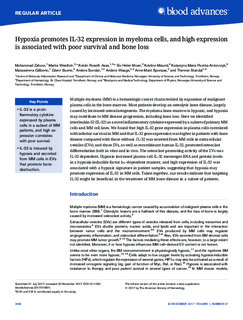| dc.contributor.author | Zahoor, Muhammad | |
| dc.contributor.author | Westhrin, Marita | |
| dc.contributor.author | Aass, Kristin Roseth | |
| dc.contributor.author | Moen, Siv Helen | |
| dc.contributor.author | Misund, Kristine | |
| dc.contributor.author | Psonka-Antonczyk, Katarzyna Maria | |
| dc.contributor.author | Giliberto, Mariaserena | |
| dc.contributor.author | Buene, Glenn | |
| dc.contributor.author | Sundan, Anders | |
| dc.contributor.author | Waage, Anders | |
| dc.contributor.author | Sponaas, Anne-Marit | |
| dc.contributor.author | Standal, Therese | |
| dc.date.accessioned | 2018-04-23T12:55:14Z | |
| dc.date.available | 2018-04-23T12:55:14Z | |
| dc.date.created | 2018-01-12T11:23:49Z | |
| dc.date.issued | 2017 | |
| dc.identifier.citation | Blood Advances. 2017, 27 (1), 2656-2666. | nb_NO |
| dc.identifier.issn | 2473-9537 | |
| dc.identifier.uri | http://hdl.handle.net/11250/2495503 | |
| dc.description.abstract | Multiple myeloma (MM) is a hematologic cancer characterized by expansion of malignant plasma cells in the bone marrow. Most patients develop an osteolytic bone disease, largely caused by increased osteoclastogenesis. The myeloma bone marrow is hypoxic, and hypoxia may contribute to MM disease progression, including bone loss. Here we identified interleukin-32 (IL-32) as a novel inflammatory cytokine expressed by a subset of primary MM cells and MM cell lines. We found that high IL-32 gene expression in plasma cells correlated with inferior survival in MM and that IL-32 gene expression was higher in patients with bone disease compared with those without. IL-32 was secreted from MM cells in extracellular vesicles (EVs), and those EVs, as well as recombinant human IL-32, promoted osteoclast differentiation both in vitro and in vivo. The osteoclast-promoting activity of the EVs was IL-32 dependent. Hypoxia increased plasma-cell IL-32 messenger RNA and protein levels in a hypoxia-inducible factor 1α–dependent manner, and high expression of IL-32 was associated with a hypoxic signature in patient samples, suggesting that hypoxia may promote expression of IL-32 in MM cells. Taken together, our results indicate that targeting IL-32 might be beneficial in the treatment of MM bone disease in a subset of patients. | nb_NO |
| dc.language.iso | eng | nb_NO |
| dc.publisher | American Society of Hematology | nb_NO |
| dc.relation.uri | http://www.bloodadvances.org/content/1/27/2656?sso-checked=true | |
| dc.title | Hypoxia promotes IL-32 expression in myeloma cells, and high expression is associated with poor survival and bone loss | nb_NO |
| dc.type | Journal article | nb_NO |
| dc.type | Peer reviewed | nb_NO |
| dc.description.version | publishedVersion | nb_NO |
| dc.source.pagenumber | 2656-2666 | nb_NO |
| dc.source.volume | 27 | nb_NO |
| dc.source.journal | Blood Advances | nb_NO |
| dc.source.issue | 1 | nb_NO |
| dc.identifier.doi | 10.1182/bloodadvances.2017010801 | |
| dc.identifier.cristin | 1541515 | |
| dc.relation.project | Norges forskningsråd: 193072 | nb_NO |
| dc.relation.project | Kreftforeningen: 4500930 | nb_NO |
| dc.relation.project | Norges forskningsråd: 223255 | nb_NO |
| dc.relation.project | Samarbeidsorganet mellom Helse Midt-Norge og NTNU: 90171600 | nb_NO |
| dc.relation.project | Samarbeidsorganet mellom Helse Midt-Norge og NTNU: 90061000 | nb_NO |
| dc.description.localcode | © 2017 by The American Society of Hematology | nb_NO |
| cristin.unitcode | 194,65,15,0 | |
| cristin.unitname | Institutt for klinisk og molekylær medisin | |
| cristin.ispublished | true | |
| cristin.fulltext | original | |
